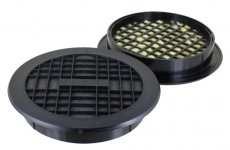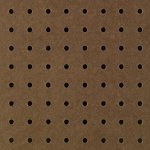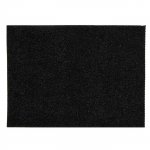Nonsense.
Nonsense, to your nonsense.
I've done this A LOT, and there can be VERY large (highly audible) differences in the result.
Ok there are going to be differences of opinions on this which is of course is to be expected... Regardless my questions relate to a ported 3 way enclosure as per my original post.
So let's start again.
PS95-8. Dayton and online calc's suggest a ported arrangement. EBP = 149.
So to use this as a mid am I better to give this it's own enclosure (approx 5L) which, because of my construction method will dictate a 6" tube or just mount it in the overall volume?
Other drivers:
T = Scan-Speak 602010
M = Dayton PS95-8
W = Dayton ES180TiA
cheers
So let's start again.
PS95-8. Dayton and online calc's suggest a ported arrangement. EBP = 149.
So to use this as a mid am I better to give this it's own enclosure (approx 5L) which, because of my construction method will dictate a 6" tube or just mount it in the overall volume?
Other drivers:
T = Scan-Speak 602010
M = Dayton PS95-8
W = Dayton ES180TiA
cheers
Remember that the enclosed volume is calculated for a particular value of low freq. extension.
You can ADD to that extension (going even lower in freq.) with a bass reflex design.
Does a midrange really need to go low for your design?
Have you considered baffle-step loss?
Have you tried a program like the edge to model baffle-step loss or open baffle?
Tolvan Data
Note that an open pipe to the rear is effectively an open baffle - it's just that the added path length from the rear/exit of the pipe around to the front of the baffle is LONGER than simply an open-baffle/plank-of-wood (with a hole in it for your driver). A longer path length means your pressure loss from phase cancellation starts lower in frequency - rather like having a much larger baffle.
An open-baffle is basically an infinity sized enclosure (say 10 cubic feet interior volume for your midrange as modeled in a calculator) **BUT** with boundary loss (based on the size of the baffle) and phase-cancellation from the output of the rear of the driver as it "wraps-around" to the front of the baffle - which causes that loss in pressure as you go lower in freq..
You can ADD to that extension (going even lower in freq.) with a bass reflex design.
Does a midrange really need to go low for your design?
Have you considered baffle-step loss?
Have you tried a program like the edge to model baffle-step loss or open baffle?
Tolvan Data
Note that an open pipe to the rear is effectively an open baffle - it's just that the added path length from the rear/exit of the pipe around to the front of the baffle is LONGER than simply an open-baffle/plank-of-wood (with a hole in it for your driver). A longer path length means your pressure loss from phase cancellation starts lower in frequency - rather like having a much larger baffle.
An open-baffle is basically an infinity sized enclosure (say 10 cubic feet interior volume for your midrange as modeled in a calculator) **BUT** with boundary loss (based on the size of the baffle) and phase-cancellation from the output of the rear of the driver as it "wraps-around" to the front of the baffle - which causes that loss in pressure as you go lower in freq..
Last edited:
Remember that the enclosed volume is calculated for a particular value of low freq. extension.
Yes, I understand this. Box is calculated for 23L Fb= 32Hz, F-3 =31Hz based on the ES180TiA TSP data.
You can ADD to that extension (going even lower in freq.) with a bass reflex design.
I don't want to go lower than F-3 =31Hz.
Does a midrange really need to go low for your design?
No. I envisaged crossing @ 400Hz.
Have you considered baffle-step loss?
Not yet... I need to determine if the PS95 can be used as a mid-driver in this scenario.
Have you tried a program like the edge to model baffle-step loss or open baffle?
Tolvan Data
Note that an open pipe to the rear is effectively an open baffle - it's just that the added path length from the rear/exit of the pipe around to the front of the baffle is LONGER than simply an open-baffle/plank-of-wood (with a hole in it for your driver).
I understand that... but I'm not intending on using this driver in an open-baffle scenario.
wait, I thought we were discussing the PS95-8? (..not the ES180TiA.)
If you aren't going to use the PS95-8 in an open tube - that's fine, but I don't see why you would need a Bass Reflex design for it.
6" diameter with corrugated foam on the interior wall and perhaps 5" length with an irregular end-cap opposite the driver should work just fine. (..a "closed" tube in the interior of the box.)
Do NOT use the mid. in a common volume with the woofer.
If you aren't going to use the PS95-8 in an open tube - that's fine, but I don't see why you would need a Bass Reflex design for it.
6" diameter with corrugated foam on the interior wall and perhaps 5" length with an irregular end-cap opposite the driver should work just fine. (..a "closed" tube in the interior of the box.)
Do NOT use the mid. in a common volume with the woofer.
Apologies if I've confused you along the way.
Ok.
So let's start again for the 2nd time.
Dayton and the online calculators used say this driver is not suited to a sealed box/chamber (EBP=149!). I am of the understanding a borderline number is anywhere between 80 - 100. So how do I set this mid- tube up?
In my mind planet10's suggestion is the only option, and allows for a degree of experimentation/tuning.
...Do NOT use the mid. in a common volume with the woofer.
Ok.
So let's start again for the 2nd time.
...6" diameter with corrugated foam on the interior wall and perhaps 5" length with an irregular end-cap opposite the driver should work just fine. (..a "closed" tube in the interior of the box.)
Dayton and the online calculators used say this driver is not suited to a sealed box/chamber (EBP=149!). I am of the understanding a borderline number is anywhere between 80 - 100. So how do I set this mid- tube up?
In my mind planet10's suggestion is the only option, and allows for a degree of experimentation/tuning.
Dayton and the online calculators used say this driver is not suited to a sealed box/chamber (EBP=149!). I am of the understanding a borderline number is anywhere between 80 - 100. So how do I set this mid- tube up?
In my mind planet10's suggestion is the only option, and allows for a degree of experimentation/tuning.
Don't worry about the EBP. Just make the volume a bit larger than its tiny Vas would suggest. I used a volume calculator and I was wrong.. length for that 6" pipe should be a minimum of 8" (not 5) - nearing 4 liters volume (..though less with an irregular rear "cap" cutting into volume).
An aperiodic design would put you all the way to the back of the loudspeaker to get the lossy vent *outside* the speaker. You can do it, but I don't think it will gain you much of anything. Qtc changes are minimal past 3 liters .03 from 3 to 4 liters and .01 past that for every liter. The low freq. response changes almost none at all with a -3db around 130 Hz and flat from 200 Hz up assuming an infinite baffle (..without baffle-step loss).
Note the "irregular cap" is mentioned to perform the task of altering high freq. reflections inside the tube - so they are NOT bouncing right back into the back of the driver's cone. While it could look like a small block-pattern diffusor, I tend to use a funnel on a dowel, the funnel reflects the sound to the foam on the interior tube.
Basically: Rear [>---<] Front with > as the funnel and < as the driver.
Last edited:
Note that an open pipe to the rear is effectively an open baffle
Not if it is damped until aperiodic.
dave
Not if it is damped until aperiodic.
dave
True, but I was referring to a fully open pipe just like kec posted.
Thanks Dave.
Tube from the rear of the baffle extending to the back is my preferred construction. The 3 1/2" driver 'swims' inside the 6" tube and gives approx 5.2L volume. I'm able to picture acoustic foam/glass insulation lining the inside of the tube, but not the back end...
wait, I use this for the back end right?
Tube from the rear of the baffle extending to the back is my preferred construction. The 3 1/2" driver 'swims' inside the 6" tube and gives approx 5.2L volume. I'm able to picture acoustic foam/glass insulation lining the inside of the tube, but not the back end...
wait, I use this for the back end right?
Attachments
..but not the back end...
wait, I use this for the back end right?
You could, but I don't know why other than tamping-down impedance some.
(..and yes, that's a commercial solution - which is nothing more than a bit of lossy fiberglass and plastic holding it in place, barely.)
(I've used those (Scanspeak) and the Dynaudio variovents before - and they can be bettered by DIY'ing. Also, I don't think it's a particularly useful design for a midrange.)
Scott I don't see another alternative TBH. But I am a novice so I'm happy to take advice...
I can't go any larger than a 6" tube which gives 5.2L. I can't (unless I'm mistaken) put this driver in a closed chamber.
It (diy aperiodic vent) could be as simple as a piece of felt glued to some peg-board - with the peg-board as your rear end/cap to your pipe and rear panel on the loudspeaker.
-and yes, you can ABSOLUTELY put it in a sealed/closed rear chamber of 5.2L.
Attachments
Last edited:
True, but I was referring to a fully open pipe just like kec posted.
His wasn’t open, damped IMF/TDL/PMC style. It will be damped, but a short quarter-wave TL. At least some of the upper harmonics are going to be gone.
i’d damp more myself.
Some test jobs. Not completely successful with these.
dave
Re closed chamber... how does that affect the sound, excursion etc etc... or am I overthinking this?
-with a 400 Hz high-pass filter you are *way* overthinking it.
..i’d damp more myself.
Some test jobs. Not completely successful with these.
dave
-what I don't like is that it tends to affect very minor excursion, and does that proverbial "suck the life out" result.
I really like aperiodic bass.. but not midrange. (..made a sonic mess of my damped cardiod designs.)
I've mentioned this a few times before in multiway and fullrange forum sections. Here is one:
"I bet another thing occurred:
..centered imaging remained about the same (maybe better, maybe worse - likely moved forward near the plane of the speakers), but off center imaging probably sounds a lot closer to the speakers (perhaps even as if its coming from the speakers).
The cleaner vocals was likely a product of removing ambient information from the track and leaving just the vocals/instruments. (..kinda like scrubbing out the sound stage.) My guess is that there would be very little change for tracks with close mic vocals and little or no hall-sound/reverb (..possibly a little better)."
-and the forum member said that's what happened when stuffing the pipe. (..on a fullrange design.)
Last edited:
-with a 400 Hz high-pass filter you are *way* overthinking it.
Ok. Now I understand why you've been entertaining a sealed enclosure... because of the 400Hz xo point.
Re "...suck the life out...", the PS95-8 is to my ears at least a little forward so this might work... there's a rise after 1KHz and a peak at say 1.8KHz.
I guess in the end I can build to test either scenario. It does suit me to extend the tube from front to back anyway so I can trial fit different configuration back panels.
-yeah, if you can try it out - definitely do so.
I'd even try it out open-back (..assuming the pipe walls are lined or you use some other method to suppress standing waves).
- Status
- This old topic is closed. If you want to reopen this topic, contact a moderator using the "Report Post" button.
- Home
- Loudspeakers
- Multi-Way
- 6" PVC for mid enclosure - considerations?


